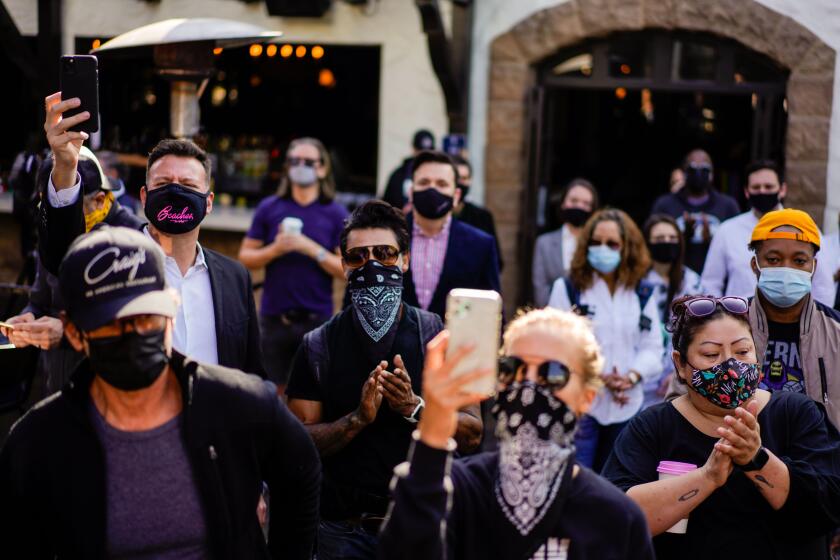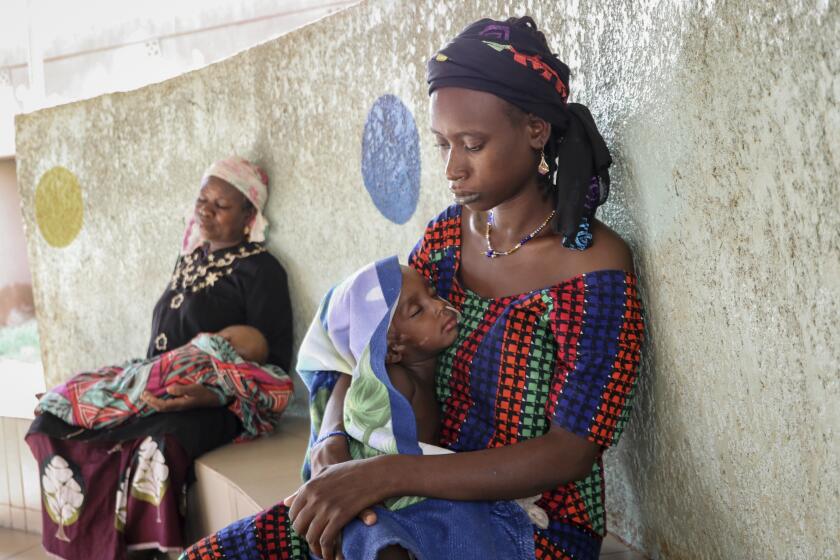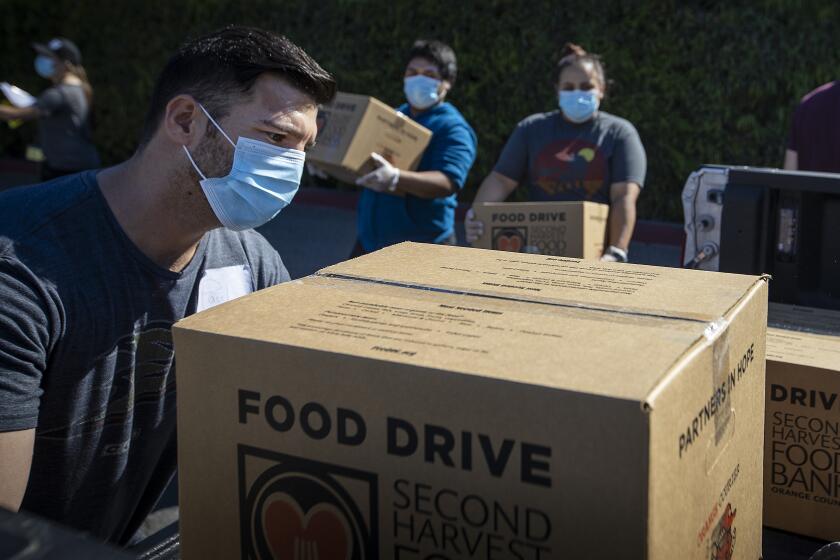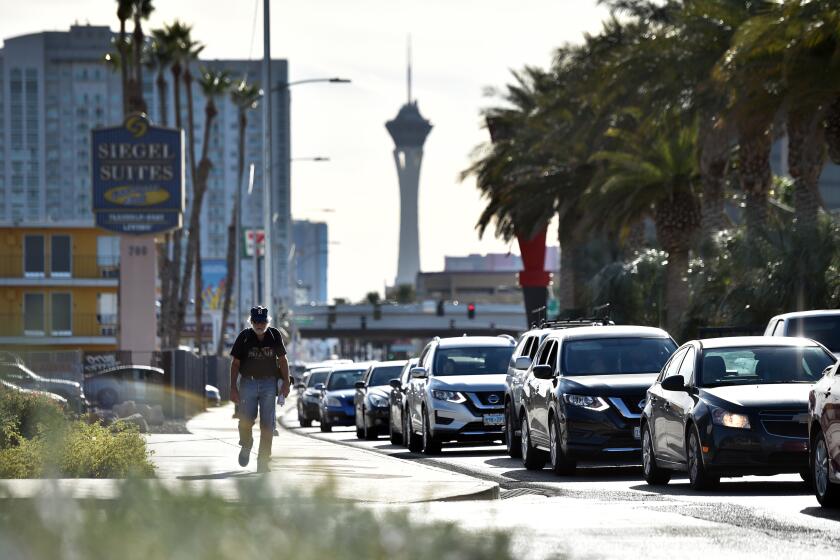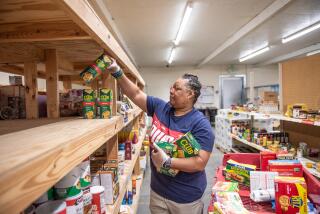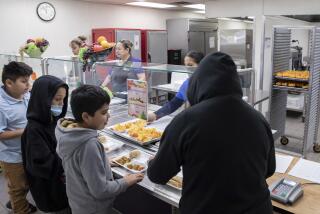Millions of hungry Americans turn to food banks for the first time

The deadly pandemic that tore through the nation’s heartland struck just as Aaron Crawford was in a moment of crisis. He was looking for work, his wife needed surgery, then the virus began eating away at her work hours and her paycheck.
The Crawfords had no savings, mounting bills and a growing dread: What if they ran out of food? The couple had two boys, 5 and 10, and boxes of macaroni and cheese from the dollar store could go only so far.
A 37-year-old Navy vet, Crawford saw himself as self-reliant. Asking for food made him uncomfortable. “I felt like I was a failure,” he says. “It’s this whole stigma ... this mindset that you’re this guy who can’t provide for his family, that you’re a deadbeat.”
Hunger is a harsh reality in the richest country in the world. Even during times of prosperity, schools hand out millions of hot meals a day to children, and desperate older Americans are sometimes forced to choose between medicine and food.
Now, in the pandemic of 2020, with illness, job loss and business closures, millions more Americans are worried about empty refrigerators and barren cupboards. Food banks are doling out meals at a rapid pace and an Associated Press data analysis found a sharp rise in the amount of food distributed compared with last year. Meanwhile, some folks are skipping meals so their children can eat and others are depending on cheap food that lacks nutrition.
Those fighting hunger say they’ve never seen anything like this in America, even during the Great Recession of 2007-09.
The first place many Americans are finding relief is a neighborhood food pantry, most connected to vast networks of nonprofits. Tons of food move each day from grocery store discards and government handouts to warehouse distribution centers, and then to the neighborhood charity.
The Crawfords turned to the Family Resource Centers and Food Shelf, part of 360 Communities, a nonprofit 15 minutes from their apartment in Apple Valley, Minn. They can receive monthly boxes of fresh produce, dairy, deli, meat and other basics — enough food to fill two grocery carts. If that runs out, they can get an emergency package to tide them over for the rest of the month.
Crawford’s wife, Sheyla, had insisted they seek help; her hours had been cut at the day care center where she worked. At first, Crawford was embarrassed to go to the food shelf; he worried he’d bump into someone he knew. He now sees it differently.
“It didn’t make me a bad man or a terrible husband or father,” he says. “On the contrary, I was actually doing something to make sure that my wife and kids had ... food to eat.”
The history books are filled with iconic images of America’s struggles against hunger. Among the most memorable are the Depression-era photos of men standing in breadlines, huddled in long coats and fedoras, their eyes large with fear. An overhead sign reads: “Free Soup. Coffee and a Doughnut for the Unemployed.”
This year’s portrait of hunger has a distinctively bird’s eye view: Enormous traffic jams captured from drone-carrying cameras. Cars inching along, each driver waiting hours for a box or bag of food. From Anaheim to San Antonio to Toledo, Ohio, and Orlando, Fla., and points in between, thousands of vehicles carrying hungry people queued up for miles across the horizon. In New York and other large cities, people stand, waiting for blocks on end.
Roughly 240,000 Californians have tested positive for the virus in the last 14 days, and about 112 have died of COVID-19 each day over the last week.
Those who are newly hungry have similar stories: Their industry collapsed, they lost a job, their hours were cut, an opportunity fell through because of illness.
Handwritten “closed” signs appeared on the windows of stores and restaurants soon after the pandemic arrived. Paychecks shrank or disappeared altogether as unemployment skyrocketed to 14.7%, a rate not seen in almost a century.
Food banks felt the pressure almost immediately.
Feeding America, the nation’s largest anti-hunger organization, scrambled to keep up as states locked down and schools — many providing free breakfasts and lunches — closed. In late March, 20% of the organization’s 200 food banks were in danger of running out of food.
The problem with supply subsided, but demand has not. Feeding America has never handed out so much food so fast — 4.2 billion meals from March through October. The organization has seen a 60% average increase in food bank users during the pandemic: About 4 in 10 are first-timers.
An AP analysis of Feeding America data from 181 food banks in its network found the organization has distributed nearly 57% more food in the third quarter of the year, compared with the same period in 2019.
There will be no quick decline as the pandemic rages on, having already claimed more than 280,000 lives and infected 14.7 million people across the nation.
Feeding America estimates those facing hunger will swell to 1 in 6 people, from 35 million in 2019 to more than 50 million by this year’s end. The consequences are even more dire for children — 1 in 4, according to the group.
Some states have been hit especially hard: Nevada, a tourist mecca with hotel, casino and restaurant industries that were battered by the pandemic, is projected to vault from 20th place in 2018 to fifth place this year in food insecurity, according to a report from Feeding America.
In four states — Mississippi, Arkansas, Alabama and Louisiana — more than 1 in 5 residents are expected to be food insecure by year’s end, meaning they won’t have money or resources to put food on the table, the report said.
Brooklynite Sharawn Vinson felt she had no choice but to send her 11-year-old twins to live with their father in North Carolina after the coronavirus pandemic threw into doubt her ability to make sure they had enough food.
You can see the look of uncertainty on their faces. Everybody’s just worried about their next meal.
— Norman Butler
In New Orleans one recent Saturday morning, Donna Duerr was waiting to pick up food in a drive-through donation — something that has become part of her routine since COVID-19 swept in last spring.
Her husband was laid off from his job as a pipefitter and she’s unable to work, having undergone two surgeries — one on her spine, the other on her arm — in the last two months. She also has two grown children who’ve moved home since the pandemic began.
“This is a hard thing to accept that you have to do this,” says a weary-sounding Duerr, her throat covered with bandages as the result of a recent operation. Every morning she monitors the local news for announcements of the next food donation; she tries to attend as many as she can, sometimes sharing the food with less-mobile neighbors.
Duerr, 56, faces painful choices. “I either pay bills or get food,” she says, though these donations have brought some relief.
Norman Butler is another first-timer. Shortly before Thanksgiving, he and his girlfriend, Cheryl, arrived at 3 a.m. at a drive-through food bank in a suburban New Orleans sports stadium. They joined a pre-dawn procession of mothers with their kids, older people and folks like him — unemployed workers.
“You can see the look of uncertainty on their faces,” he says. “Everybody’s just worried about their next meal.”
Before the pandemic, Butler, 53, flourished in the tourism-dominated city, working as an airport shuttle and limousine driver, a valet and hotel doorman. Since March, when the bustling streets turned silent, jobs in the city have been scarce.
“A lot of people are in limbo,” he says. “The main thing we need is to get back to work.”
::
Low-wage employees, many in the service industry, have borne the brunt of economic hardship. But the misery has reached deeper into the workforce.
A September report commissioned by the Food Research & Action Center, an anti-hunger organization, found 1 in 4 of those reporting they didn’t have enough to eat typically had incomes above $50,000 a year before the outbreak.
In Anchorage, Brian and Airis Messick were coasting along in full-time jobs for companies that support the state’s oil industry. They were moving toward buying a house.
When March arrived, everything unraveled.
Brian, 28, the newest hire at an electrical wiring company, was laid off. Within a week, Airis, an office worker at an oil well testing firm, lost her job, too.
Then it became a monthly game of deciding who gets paid first with their unemployment checks — the landlord or one of the many bills. They kept their car filled with gas in case they had to move.
The Messicks and their 9-year-old son, Jayden, tried to survive on $50 to $75 a week because, she says, “that’s all we could squeeze.” They turned to a food bank for only the second time — they’d sought help after Hurricane Irma hit Florida in 2017.
After that devastation, the Messicks, who’d met in Florida, decided to get a fresh start and move to Alaska, where Airis had grown up.
I feel great knowing that we’re not alone, that we’re, you know, not out here being the only one suffering but it makes me mad to know my government failed us.
— Airis Messick
Airis, who just turned 30, found work in August, ironically, at the state unemployment office. “I hear people’s stories all day,” she says. “I listen to moms cry about not having money to take care of their kids. My heart aches for the people who get denied.”
Brian stays home with Jayden, who is autistic, helping him with school and driving him to appointments. Also part of the family are Cleo, a pit bull-lab mix, and Daisy, a bearded dragon.
As a new stay-at-home order came for much of California, daily new coronavirus cases in Los Angeles County are increasing at an even faster pace than officials had forecast earlier in the week.
Airis earns too much for the family to receive state financial aid. Anchorage’s high cost of living, partly fueled by the expense of shipping goods to the nation’s most northern state, makes it harder to economize even with coupons and careful shopping.
She says the family will continue to go to the food bank until the economy improves, which she expects won’t be soon.
There should be better systems in place, she says, to help families.
“I feel great knowing that we’re not alone, that we’re, you know, not out here being the only one suffering,” she says, “but it makes me mad to know my government failed us.”
::
For communities of color, the pandemic has been a compound disaster with Black and Latino people reeling from disproportionately high rates of deaths, infections — and joblessness.
Unemployment surged among Latino people to 18.9% this spring, higher than any other racial and ethnic group, according to federal statistics. Though it has since fallen, many are still struggling.
More than 1 in 5 Black and Latino adults with children said as of July they sometimes or often did not have enough to eat, according to the commissioned report. That was double the rate of white and Asian households. It also found that women, households with children and people of color are at greatest risk of hunger.
Abigail Leocadio, 34, first approached the nonprofit Society of St. Vincent de Paul in Phoenix during hard times about a decade ago. Her family rebounded and she completed training to become a phlebotomist, landing a job drawing blood specimens for a local lab.
The United Nations says coronavirus-linked hunger is leading to the deaths of 10,000 children a month in the first year of the global pandemic.
Leocadio was just 7 when her family brought her to the U.S. from their native Cuernavaca, Mexico. She currently is protected from deportation and has a work permit through the Deferred Action for Childhood Arrivals program, or DACA.
When her husband, a restaurant cook, was laid off earlier in the pandemic, her income — barely more than the $11 state minimum wage — wasn’t enough to cover their expenses.
I never thought it would be me. But you do what you gotta do to survive.
— Briana Dominguez
Though they own a two-bedroom trailer, they pay $500 a month to rent the lot. Add to that as much as $450 in monthly electric bills and internet service so their four kids, 9 to 15, can attend class remotely. Before schools closed, the kids received free breakfasts and lunches on campus.
“It has been hard feeding all the kiddos daily,” Leocadio said outside the trailer after a recent delivery from the charity of two boxes including canned tomatoes, dried beans, rice, breakfast cereal and the kids’ undisputed favorite: specialty Oreo cookies.
The food, she says, provides less than half of what her family eats in four weeks, but significantly reduces their monthly bill to about $250. Before the pandemic, the family was saving to buy a house, but that money has been wiped out. Her husband, though, is back at work.
“We always figure out things one way or another,” Leocadio says, though she’s worried about the surge in coronavirus cases and what lies ahead. “We really don’t know what’s going to happen.”
Briana Dominguez had been depending on food pantries in the Chicago area since last fall to supplement her groceries. With two sons, ages 3 and 14, it was hard to keep up, even though she and her boyfriend both worked full-time.
“I never thought it would be me,” she says of her visits to the Hillside Food Pantry in Evanston, Ill. “But you do what you gotta do to survive.”
If you have extra food, here’s how you can help local food banks or pantries. If you are struggling to buy food, this guide has information for you.
A series of misfortunes brought them to a turning point.
Dominguez had a miscarriage, and her father lost his job due to the pandemic. So did her boyfriend, a trucker. In November her company, which sells ceiling tiles for hospitals and other business, eliminated her job with little notice.
Dominguez, 34, who has a small severance, has decided to move to Georgia, where she has family and living costs are lower. Her boyfriend has found work as a customer service representative that he can do from anywhere, though it pays only $13 an hour. She traveled there in early December to scout job possibilities.
“If I don’t do it now,” she says, “I’ll never do it.”
::
While food banks have become critical during the pandemic, they’re just one path for combating hunger. For every meal from a food bank, a federal program called the Supplemental Nutrition Assistance Program, or food stamps, provides nine.
Anti-hunger groups have lobbied Congress for a 15% increase in maximum food stamp benefits. A similar measure went a long way in digging the nation out of the Great Recession. A stimulus bill passed by the House this spring includes such a provision, but it has been bogged down in partisan squabbling.
“Food banks and food pantries are doing great work,” says Luis Guardia, president of thee Food Research & Action Center. “But they simply cannot do enough to be something of the order of magnitude that we’re seeing right now. ”
Many going to food pantries also are receiving food stamps, though eligibility varies among states.
Aaron Crawford says the addition of $550 in food stamps the family started receiving last summer has made a significant difference in their lives.
Although unemployment rates in Nevada have recently decreased, the number of people without jobs in September was 134,756 higher than a year earlier.
Others have discovered they couldn’t make it without food help, even with Social Security or other benefits.
Phyllis Marder, 66, had both Social Security and unemployment when she arrived at the Hillside Food Pantry in Evanston, Ill., where she’s lived in the same bungalow for 20 years.
She’d been supplementing her benefits as an Uber drive, and when the pandemic hit, she helped workers bring home their computers and office gear. After that, she ferried medical and other frontline workers, but that came to an abrupt end with a COVID-19 scare.
At first, Marder didn’t tell anyone about visiting food pantries. Then she had a change of heart. “Keeping a secret makes things get worse,” she says, “… and makes me feel worse about myself, and so I decided that it was more important to talk about it.”
Marder sometimes shared her food with neighbors and a panhandler on a freeway ramp. But she expects her food bank visits will end soon.
In a few days, she starts a job — courtesy of the pandemic.
She’ll be a coronavirus contact tracer, working remotely for a nearby county.
::
As the year nears its end, Crawford is more confident.
The months have been filled with setbacks and successes. Both Crawfords developed mild cases of COVID-19. Sheyla had hysterectomy surgery and was out of work without pay for six weeks.
But they’ve rebounded, too.
Crawford has two part-time jobs, one at United Parcel Service, the second as a maintenance worker at a home for older people. His wife is back at work at the day care center. And their boys are receiving breakfast and lunch at their school that provides day care.
The financial troubles that brought them to the food bank haven’t disappeared. They still have overdue bills and a car that needs repairs.
But after many dark months, there have been moments of relief. This fall when the couple contracted COVID-19, their sons’ school sent meals and milk to help.
And a friend had an 18-pound turkey delivered for a Thanksgiving feast. It was so big the Crawfords had to figure out how to find room for the leftovers in the refrigerator now stocked with food.
A full fridge, Crawford says, is a welcome sight.
“It just kind of puts you at ease,” he says. “There’s a sense of peace.”
More to Read
Sign up for Essential California
The most important California stories and recommendations in your inbox every morning.
You may occasionally receive promotional content from the Los Angeles Times.


